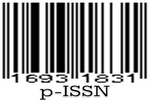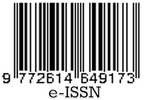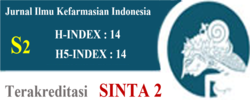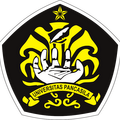Separation Selectivity of Isoniazid and Asetilisoniazid in Human Plasma In-vitro by High Performance Chromatography
Abstract
Bioanalysis method is needed to pharmacokinetic study of INH as antituberculosis. The main problem is INH structure is similar to that of acetyl isoniazid (AcINH) as its metabolite. Therefore, a selective separation method is needed to separate the INH from its metabolite and matrix. The aim of this study was to test the selectivity of separation method of INH and AcINH in human plasma in-vitro by high performance liquid chromatography (HPLC). The HPLC system used a reversed phase with UV detector and hexane sulphonate as an ion counter. The optimum conditions was obtained by using C18 as stationary phase, hexane sulphonate (pH 2.47)-methanol (65:35) as mobile phase, with flow rate of 1mL/min, and UV detector at wavelength of 265nm. The selectivity of method separation was indicated by a resolution value of ≥ 1.5. The tailing factor for INH and AcINH were 1.297, dan 1.912, respectively. The k values ware less than 10 and N values were greater than 5000 indicate good separation efficiency. The developing of HPLC was a selective for separating of INH and AcINH in human plasma in-vitro.
References
2. Klein DJ, S Boukouvala, EM McDonagh, SR Shuldiner, N Laurieri, CF Thorn, RB Altman, TE Klein. PharmGKB summary: isoniazid pathway, pharmacokinetics. Pharmacogenet Genomics; 2016. 26(9): 436–444.
3. Teixeira RLF, RG Morato, PH Cabello, LMK Muniz, ASR Moreira, AL Kritski, FCQ Mello, PN Suffys, AB Miranda,
dan AR Santos. Genetic polymorphisms of NAT2, CYP2E1 and GST enzymes and the occurrence of antituberculosis drug-induced hepatitis in brazilian TB patients, Mem Inst Oswaldo Cruz. 2011. 106 (6). Rio de Janeiro. Sept. ISSN 0074-0276. http://dx.doi.org/10.1590/S0074-02762011000600011.
4. Stella. Optimasi dan validasi metode analisis isoniazid dan pirazinamid dalam tablet 4 fixed dosecombination(4FDC) dan plasma in vitro secara kromatografi cair kinerja tinggi [Skripsi] FMIPA UI. 2011.
5. Madhavi R, Mohana KA, Shobha RG, Mounika D. Isoniazid: A Review of Analytical Methods. Asian J. Pharm. Ana. 2015. 5(1):41-5.
6. Bhandari R, IP Kaur. A sensitive HPLC method for determination of isoniazid in rat plasma , brain, liver, and kidney, J Chromat Separation Techniq, 2012. 3(3):1-5. ISSN2157-7064 JCGST.
7. Kumar AKH, V Sudha, G Ramachandran. Simple and rapid method for simultaneous determination of isoniazid and acetylisoniazid in urine by hplc. Asian J Biomed and Pharm Sci. 2014. 4(34):46-50.
8. Kemenkes. Farmakope Indonesia V. Direktorat Jendral Bina Farmasi dan Alat Kesehatan. Kementerian Kesehatan RI. 2014. ISBN 987-602-235-463-5:567-9.
9. EMEA (European Medicines Agency). 2012. Guideline on bioanalytical method validation. EMEA/CHMP/EWP/192217/2009.
10. FDA (Food Drug Administration). Guidance for industry bioanalytical method of validation; available from: www.fda.gov/cder/guidance/index.htm. 2018.
11. Atta NF, A Galal, RA Ahmed. Voltammetric behavior and determination of isoniazid using PEDOT electrod in presence of surface active agents. Int J Electrochem Sci. 2011. 6(10):5097-113.
12. Oommen V, Ganesh G, Vadivel K, Kanthakumar P. The Henderson-Hasselbalch equation : a three dimensional teaching model.Indian Journal of Physiology and Pharmacology. 2016. 60(1):70-75.
13. Brown SA, NA Ezejiofor, OE Orisakwe. Pharmacokinetics of isoniazid with or without ofloxacin. International Current Pharmaceutical Journal. 2012.1(12):403-9.
14. Skoog DA, DM West, FJ Holler. SR Crouch. Fundamental of analytical chemistry. Ninth Edition. Mary Finch Publisher. 2014. ISBN-13: 978-0-495-55828-6. ISBN-10: 0-495-55828-1
15. Snyder LR, JJ Kirkland, JW Dolan. Introduction to modern Liquid Chromatography. Third Edit. United States of America: Wiley Publication. 2010.

This work is licensed under a Creative Commons Attribution-NonCommercial-ShareAlike 4.0 International License.
Licencing
All articles in Jurnal Ilmu Kefarmasian Indonesia are an open-access article, distributed under the terms of the Creative Commons Attribution-NonCommercial-ShareAlike 4.0 International License which permits unrestricted non-commercial used, distribution and reproduction in any medium.
This licence applies to Author(s) and Public Reader means that the users mays :
- SHARE:
copy and redistribute the article in any medium or format - ADAPT:
remix, transform, and build upon the article (eg.: to produce a new research work and, possibly, a new publication) - ALIKE:
If you remix, transform, or build upon the article, you must distribute your contributions under the same license as the original. - NO ADDITIONAL RESTRICTIONS:
You may not apply legal terms or technological measures that legally restrict others from doing anything the license permits.
It does however mean that when you use it you must:
- ATTRIBUTION: You must give appropriate credit to both the Author(s) and the journal, provide a link to the license, and indicate if changes were made. You may do so in any reasonable manner, but not in any way that suggests the licensor endorses you or your use.
You may not:
- NONCOMMERCIAL: You may not use the article for commercial purposes.
This work is licensed under a Creative Commons Attribution-NonCommercial-ShareAlike 4.0 International License.

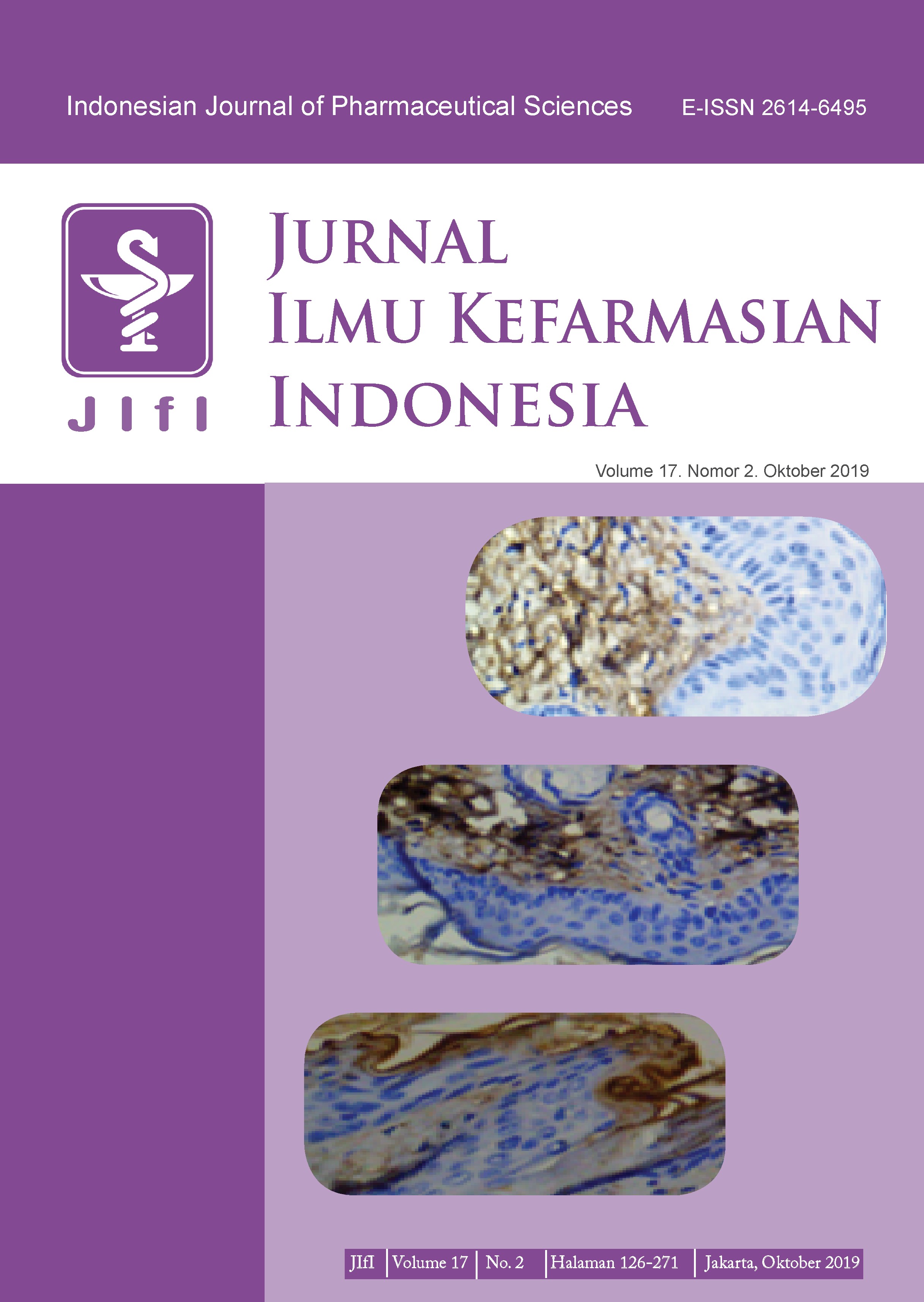



 Tools
Tools

